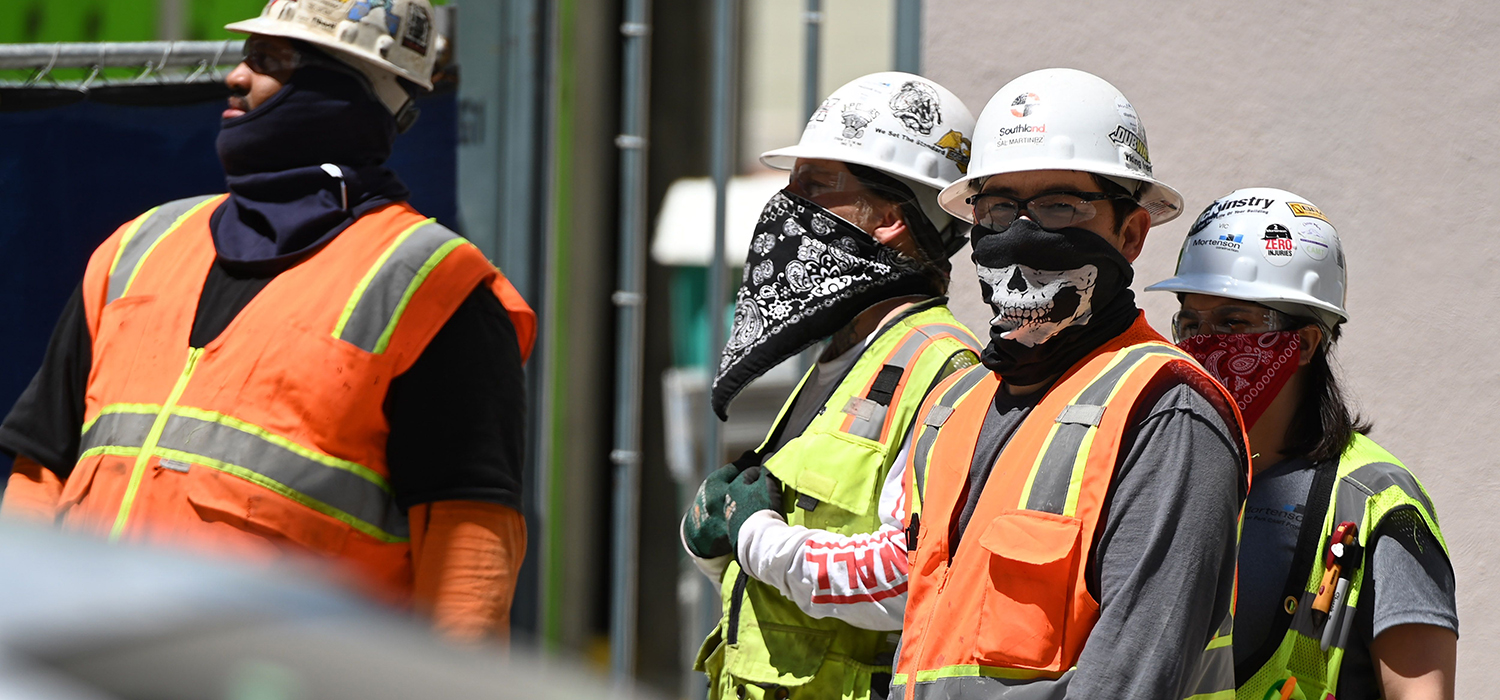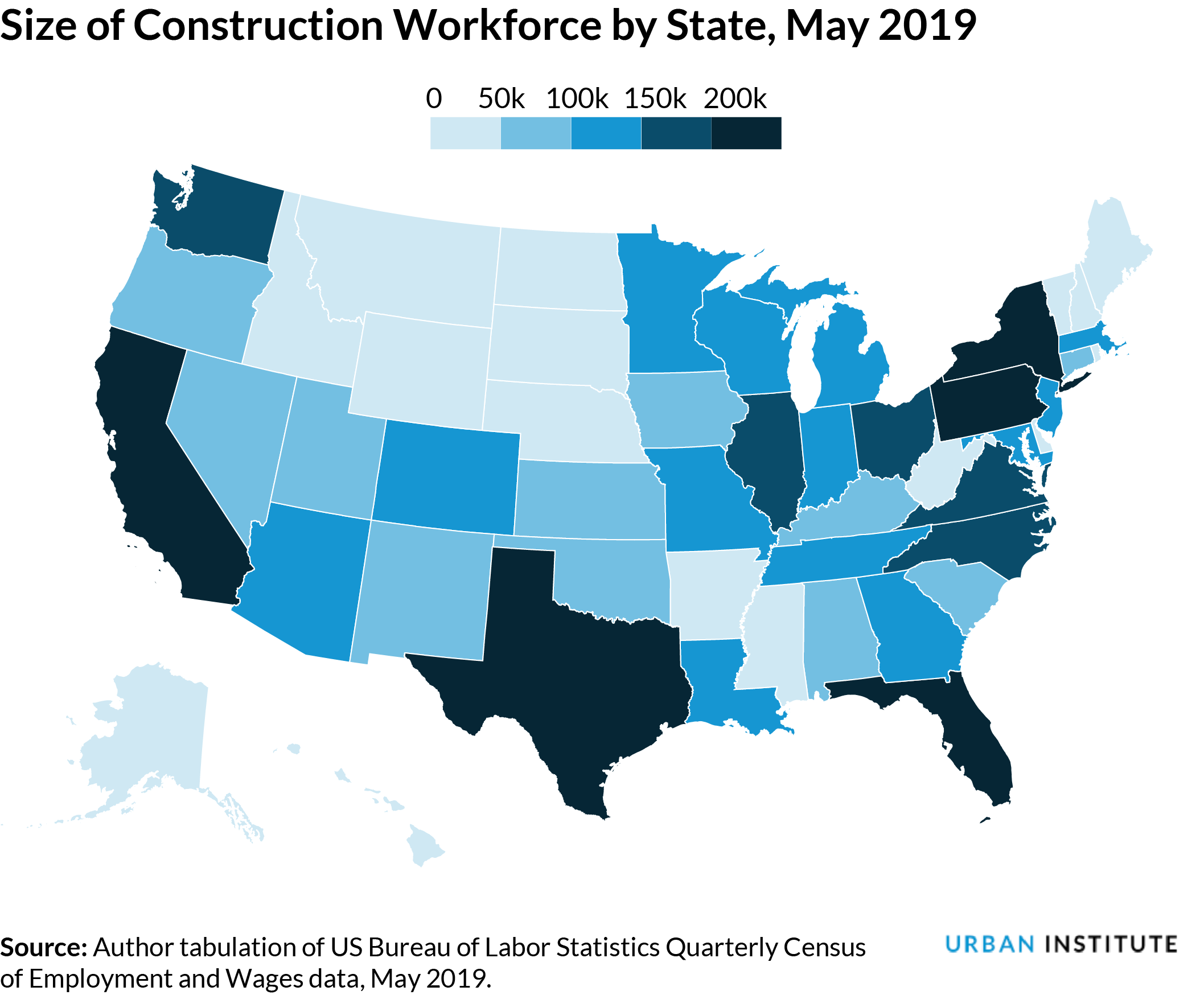
<p>Construction workers wear face coverings in downtown Los Angeles, California during the coronavirus COVID-19 pandemic on April 14, 2020. (Photo by ROBYN BECK/AFP via Getty Images)</p>
States and cities across the US are taking various approaches to designating construction activity as “essential” work; many places are allowing it to continue during the pandemic. Like a few other sectors, this means the building construction and maintenance industry has been allowed—and even encouraged—to continue work that can’t be done at home.
Regardless of the ongoing debate about whether construction activity is economically essential, minimal guidance exists on how construction work can be safe for workers. OSHA general guidelines (PDF) for all industries were released in March, relying primarily on existing standards. Enforcement rules for essential industries were issued in mid-April—two and a half months after the Department of Health and Human Services declared a national public health emergency.
A new University of Texas study suggests that construction workers may contract COVID-19 at a higher rate than the general public because of their working conditions. But most construction workers are still going to work, choosing between their families’ financial well-being and their physical health. The demographic composition of today’s construction workforce makes these decisions even more complicated, as Latino immigrants make up a large share of these workers.
Workers with low incomes are more likely to become unemployed and face financial duress without sufficient health insurance and safety nets. With legislation being proposed in this area now, several questions arise: what about the physical risks to workers in occupations that must work? What are their backgrounds, and what protections do they have?
Where does construction work continue?
Each place is allowing construction projects differently, though many are following the US Department of Homeland Security’s March 28 advisory note (PDF) that largely deemed all industry sectors as essential. The City of Boston was first to implement strict prohibitions on construction activity but is now considering removing some restrictions. Other cities like Chicago, Austin, San Francisco, and New York City have applied their restrictions to only certain sectors—often because of preemptive state mandates.
Washington State, Pennsylvania, Michigan, and New York State have proposed statewide strict rules but with a few exceptions, such as building and maintaining affordable housing, private energy infrastructure, or publicly funded projects. In contrast, California allows construction of most housing and public works. In other places, construction of sports facilities and large private employers’ new facilities is permitted. In some states, projects have been expedited with the rationale of minimizing interruptions and maintaining any possible economic activity.

Most states and cities are permitting emergency repairs for residential owners and renters. Some private and public property owners are implementing further restrictions on repair work, potentially at the risk of leaving all deficiencies unrepaired, according to some renters. Contractors and building trades employers are also lobbying to ensure their projects fall within jurisdictions’ definitions of essential work.
Who are our nation’s construction workers?
A few states with strict prohibitions also house large construction employers, many of whom are pushing for looser regulations.

Consequently, work orders are regularly amended as jurisdictions continue to strike a balance between services essential to society, economic activity, and worker safety. In places like Texas, Florida, and Georgia—with sizable construction workforces and few pandemic-related prohibitions—tens of thousands of workers are showing up at their job sites.
As each place’s definition of essential construction varies, so does its construction workforce. As Urban has studied, construction jobs are dominated by Latino immigrants, many without documentation. At least one-third of construction workers are immigrants, and Latinos, both foreign- and US-born, hold the vast majority of construction jobs in many high-growth areas.

How are construction workers being protected?
Pandemic responses are a work in progress. After providing guidance for in-home repair work, OSHA recently released an alert with construction safety tips. Some states have supplemented this guidance to cover all construction work with requirements similar to those issued to the general public, such as six-feet distancing (though most construction activities cannot comply), cleaning supplies for surfaces and equipment (though they are physically prohibitive on job sites), and the provision of personal protective equipment (though most employers cannot locate and purchase it).
Coronavirus safety precautions remain unclear, are not posted at job sites, are often ignored, or are simply not possible given the nature of construction activity. Workers are increasingly expressing worry, with some walking off the job. The first reports of construction workers testing positive for COVID-19 and spreading the disease to coworkers are starting to surface.
Construction was already among the most challenging workplaces regarding safety, with one out of five fatal occupational injuries in the country in construction. With the arrival of discretionary enforcement standards and some cities closing their building departments, labor and safety inspections are inconsistent or stopped altogether, even where construction is still happening.
Wage protections are also a critical concern, particularly given so many of these workers’ precarious status. Longer-term efforts to reduce existing construction regulations and their enforcement, combined with slippages that occur during emergency conditions, will lead to more suffering for these workers in addition to the stress they’re already facing.
Attention to worker safety and wage protections does not map evenly between states with current construction restrictions and large workforces. Many states that have either declared no work restrictions or deemed all construction as essential are also places with numerous worker exploitation, misclassification, and wage theft reports (PDF).
Supports to protect workers facing unsafe conditions and economic uncertainty
In places where construction activity has stalled, the construction industry is rightfully concerned about when they can start working again.
We estimate that up to a fifth of construction workers could be temporarily not working, as 29,000 construction jobs (PDF) were lost in March. Supplemental assistance for families with low and middle incomes who have lost or will lose their jobs during this time is critical. And that assistance should apply to all of these construction workers; for example, California Governor Newsom recently instituted worker protections for undocumented immigrants in the essential workforce.
But adequate resources must also be dedicated to securing safety and worker protections for people who continue to work where it is possible. Some jurisdictions are stepping up to implement stricter safety protocols. Los Angeles Mayor Garcetti has instituted new coronavirus-specific construction inspection measures and enforcement procedures to deal with its more inclusive list of allowed construction—a potential model for other jurisdictions looking to strike the right balance.
The meaning of essential work is taking new forms during this pandemic, but we must treat workers with the same value that we attribute to their work.
Let’s build a future where everyone, everywhere has the opportunity and power to thrive
Urban is more determined than ever to partner with changemakers to unlock opportunities that give people across the country a fair shot at reaching their fullest potential. Invest in Urban to power this type of work.